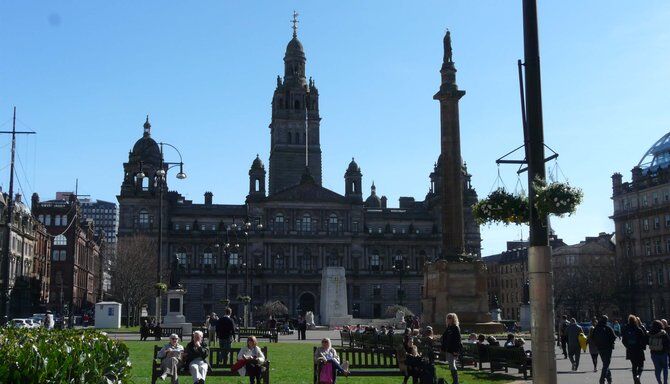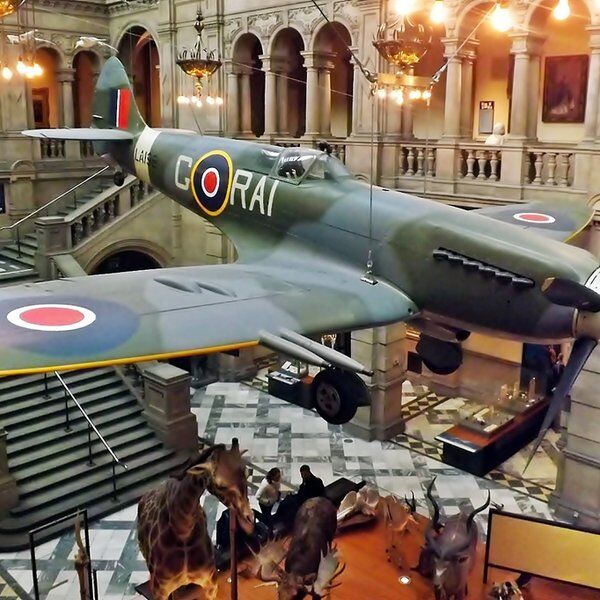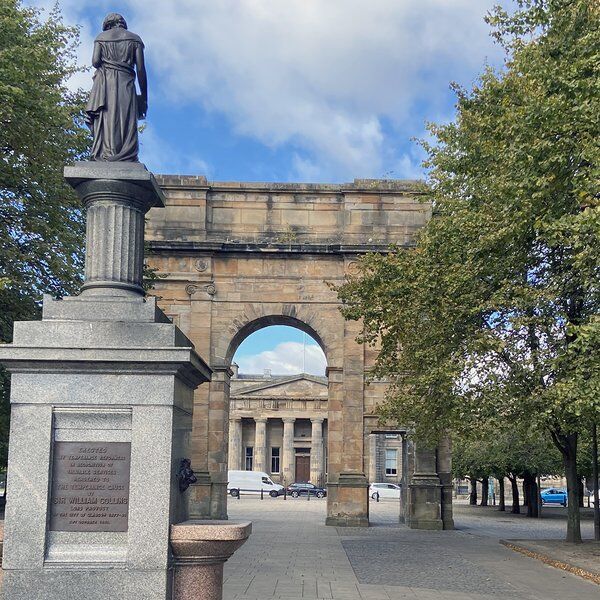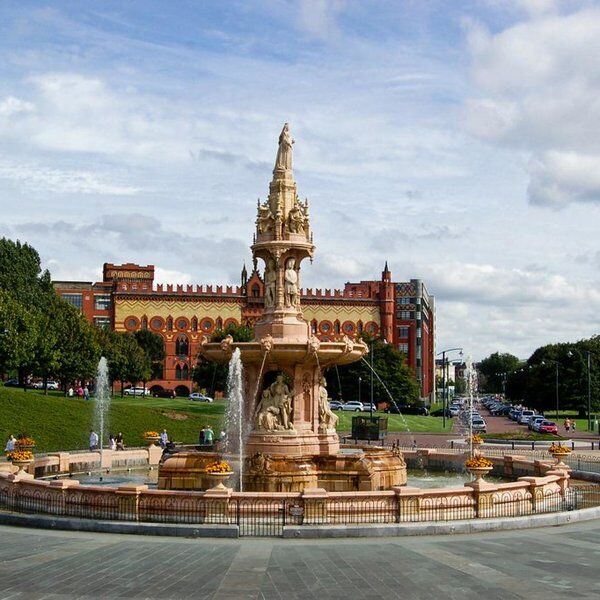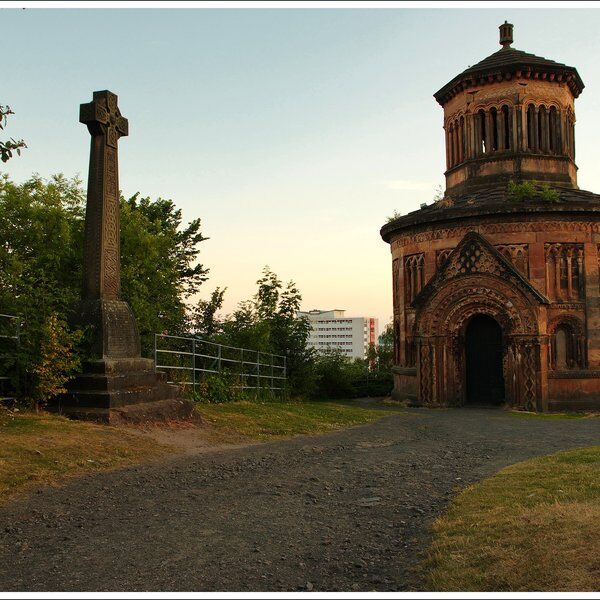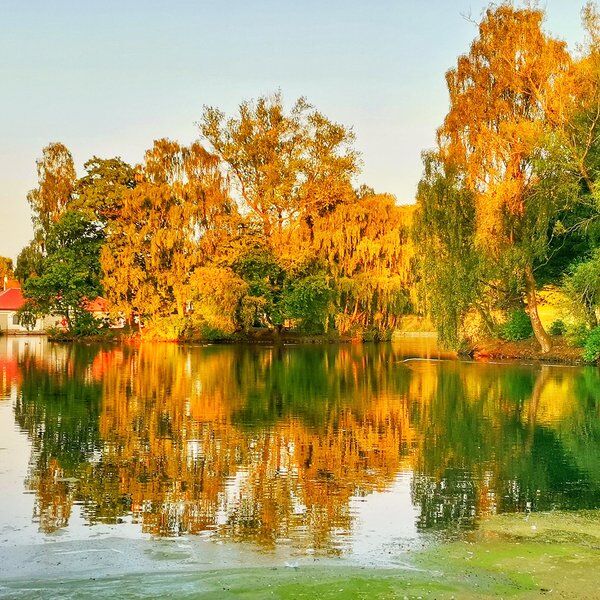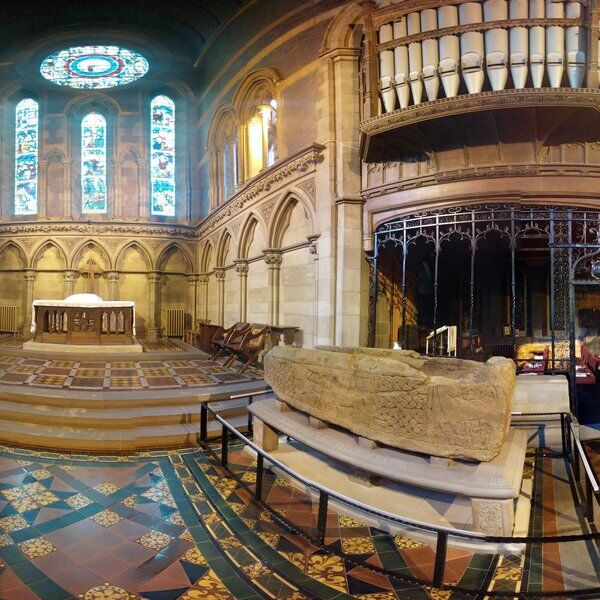George Square is the nucleus of Glasgow’s city centre, serving as a formal and informal meeting place for annual events or casual gatherings. It was laid out in 1781 and named after the United Kingdom’s Hanoverian King, George III.
Beyond its importance as an assembly point, George Square Glasgow is home to eleven of the city’s statues, including politicians, authors, poets, inventors and royals.
History of George Square Glasgow
At the dawn of the 18th century, Glasgow was little more than a crowded town. Few aspects of the city had changed since Medieval times; although its streets and alleyways bore the scars of recent politically, socially and economically tumultuous history.
Additionally, Glaswegians were in uproar. While Scottish and English subjects had shared a monarch since 1603, they were separate kingdoms with their own parliaments, laws, and customs. This had inhibited Scotland’s ability to trade with England’s colonies, namely in North America, where sugar, cotton and tobacco were rapidly becoming Europe’s most prized resources.
The 1707 Act of Union would change all that. Despite the outrage shown by its residents, time would show that Glasgow, perhaps more than any other Scottish city, would benefit from the Union. For the first time, Scotland could directly import and export goods from North America. Helpfully, Glasgow’s relatively new quay, built in 1674, made it the closest port to the American continent. Within a few decades, Glasgow became the biggest importer of tobacco in Britain, and all that wealth had led to a boom in wealth (for some) and an increased interest in beautifying the city.
Following US Independence in 1775, the Tobacco Lords of Glasgow had to go slightly further afield to maintain their status and cash flow. The West Indies were still a British colony, and provided sufficient quantities of tobacco, sugar, and cotton to satiate Europe’s growing appetite.
As for the rest of Glasgow’s residents, not everyone was happy about the unification of Scotland and England. However, the working class residents, who were the majority of Glasgow’s population, did reap some “benefits” from the city’s economic boom. By the late 18th century, there were plenty of jobs available for dockers and factory workers. Whilst they were low paid and extremely dangerous, it was more desirable than poverty or relying on meagre poor relief.
As for the wealthier classes, they began looking around for ways to develop Glasgow and compete with its more exuberant Scottish city counterpart, Edinburgh. Plans were drawn up to modernise and tidy up Glasgow’s streets. Meanwhile, the city expanded westwards and new streets were patriotically named after wealthy merchants or royals.
The new western part of Glasgow was a demarcation in territory for the wealthier classes.
In 1781, a new square was laid out primarily to be used for residential purposes. It was far enough away from the working class urban centre to be considered ‘proper’ whilst also conveniently situated close to the economic nucleus of Glasgow Cross. It was named George Square, after the then king, George III, and within a few decades it was home to some of the most elegant buildings in the city.
George Square Glasgow Surrounding Buildings
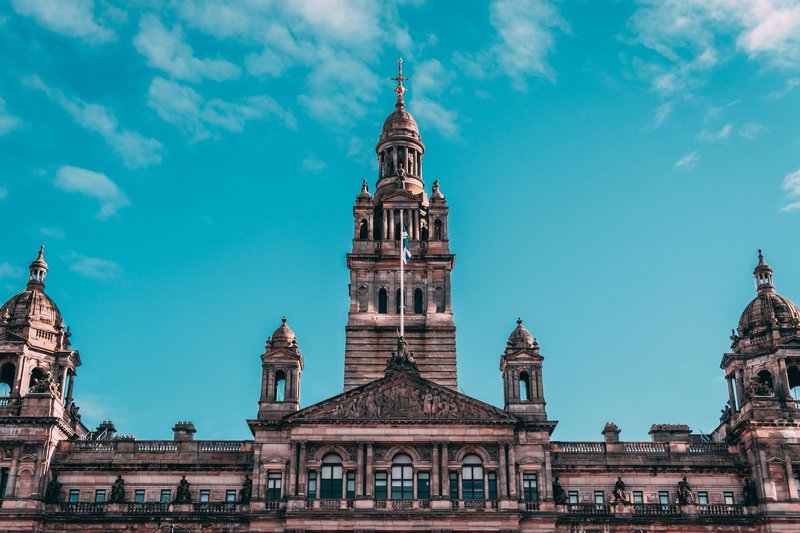
Following its development, George Square Glasgow became an attractive centre for residential and commercial buildings.
During the Georgian period, from the late 1780s until the 1820s, townhouses dominated the perimeter edge of George Square while the square itself remained a kind of dumping ground for excess soil and building materials. Part of it was fenced off to allow sheep to graze, and the first statue to be erected on the Square was introduced in 1819, depicting Sir John Moore of Corunna.
By 1825, George Square was in need of a revamp. The man in charge of renovations was Stewart Murray, who had been the landscape architect of the Royal Botanic Gardens in Sandyford. Murray gave the Square an aesthetic makeover, adding walkways, trees and greenery, enclosing his work in iron railings.
From the onset of the Victoria era, the residential buildings surrounding George Square were torn down or replaced with commercial or civic buildings. Houses were converted into hotels to meet the increasing demand of visitors thanks to Glasgow’s newly-opened railway station, Queen Street Station, in 1842. Impressive Victorian structures such as the Bank of Scotland, General Post Office and City Chambers also appeared, all of which still stand today although the Post Office has been converted into offices.
George Square Glasgow Statues and Monuments
Over the years, George Square Glasgow has accumulated an impressive collection of statues and monuments to various historical figures.
There are eleven statues and monuments in total, each having secured their place in Scottish history. In recent years, the statues have been the subject of fierce debate and discussions regarding representation and colonial legacy.
Political debates aside, the statues and monuments in George Square Glasgow are also renowned for their dubious accessories - it is not uncommon to find the statues wearing traffic cones, football merchandise or being climbed by excited fans.
However, on a typical day in Glasgow, you’re likely to find the statues amidst a flock of pigeons or curious onlookers. Here are some of the most interesting stories behind the George Square Glasgow statues and monuments…
Sir Walter Scott
The Sir Walter Scott Monument was erected in 1837 and is the oldest monument in George Square Glasgow. It was commissioned five years after his death and was the first monument to commemorate the famous author and poet.
The foundation stone was laid on Monday 1st of October, and involved a procession involving the Magistrates of Glasgow, Sheriffs from Lanark, Dumbarton and Renfrew and the 9th Lancers from Court Hall to George Square. The sculptor of the marble statue of Scott was John Greenshields.
Queen Victoria and Prince Albert
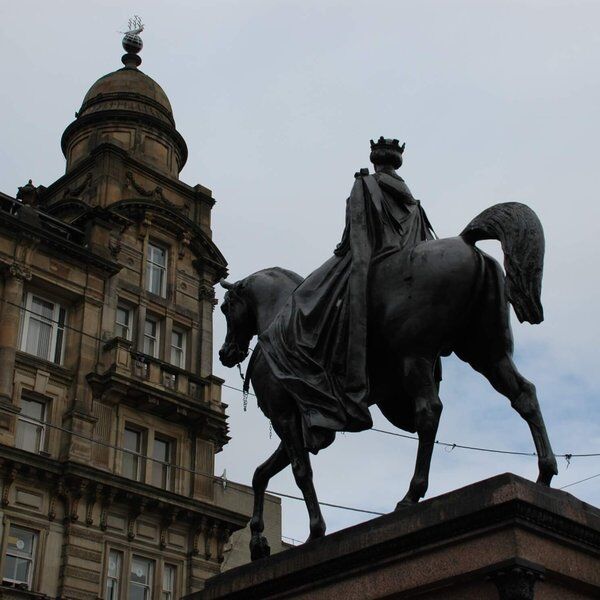
There are only two known sculptures of Queen Victoria on horseback, and both of them are in Glasgow. The statue of Queen Victoria riding a horse in George Square Glasgow was the first ever to depict a woman on horseback, and was erected in 1854.
Opposite his wife stands a statue of Prince Albert, also depicted on horseback. It was erected in 1866.
Both sculptures were designed by Carlo Marochetti, who also designed the Royal couple’s sculptures at Frogmore Mausoleum in Windsor.
Robert Burns
The statue of Robert Burns, Scotland’s national poet, Erected on Thursday the 25th of January 1877. The monument was paid for by public subscription, and its unveiling was witnessed by an estimated 100,000 people. 25,000 people joined a procession to the unveiling, where Lord Houghton revealed the monument. It was designed by George Edwin Ewing.
Other Statues and Monuments in George Square Glasgow
Keep an eye out for these other statues and monuments in George Square Glasgow:
- James Watt, Scottish inventor who improved the steam engine (erected 1832)
- Sir Robert Peel, a former British Prime Minister and founder of the modern British police force (erected 1859)
- Thomas Campbell, a Scottish poet (erected 1877)
- Field Marshal Lord Clyde, a British Army officer who served during the Indian rebellion of 1857 (erected 1868)
- Sir John Moore, a Lieutenant General who gained renown during the Peninsular War against Napoleon (erected 1819)
- James Oswald, a politician and landowner (erected 1856)
- William Ewart Gladstone, four-time British Prime Minister (erected 1902)
Events and Gatherings at George Square Glasgow
As the main public square in Glasgow, George Square hosts a variety of events throughout the year. Some events involve annual traditions such as Christmas, Hogmanay and Remembrance Day, others involve celebrating sporting events or enjoying various aspects of culture such as food, music or comedy.
Here are a few of the most significant events and gatherings at George Square Glasgow:
Christmas at George Square Glasgow
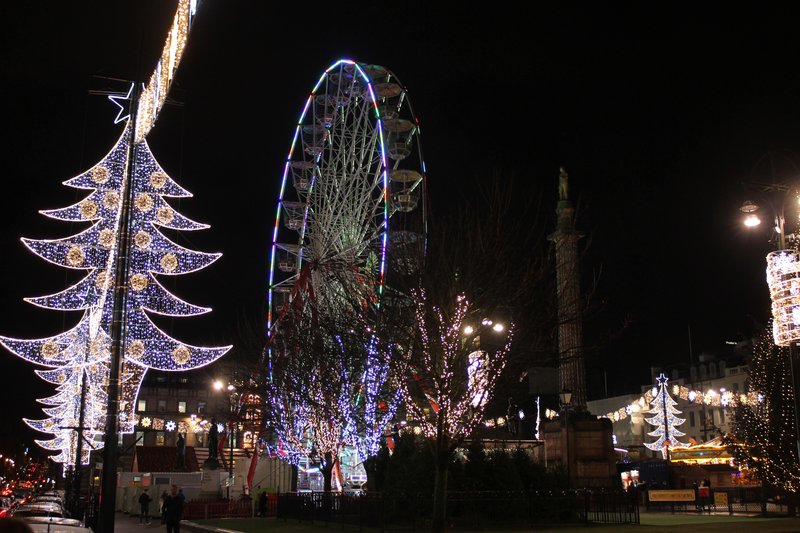
Most winters, George Square undergoes a festive transformation that brings Glasgow a little closer to Lapland. This begins with the annual Christmas lights switch-on in mid to late November, and involves the opening of the Christmas market, an ice-skating rink, fairground attractions such as a Helter Skelter, and of course, plenty of festive music.
Hogmanay at George Square Glasgow
The Scots word for New Year’s Eve is Hogmanay, and many Glaswegians previously chose to ring in the new year at George Square. From 1939 until 2011, the Square would be filled with people and raucous celebrations. Since then, however, Hogmanay celebrations at George Square have been moved mostly to daytime activities.
Political Demonstrations and Rallies at George Square Glasgow
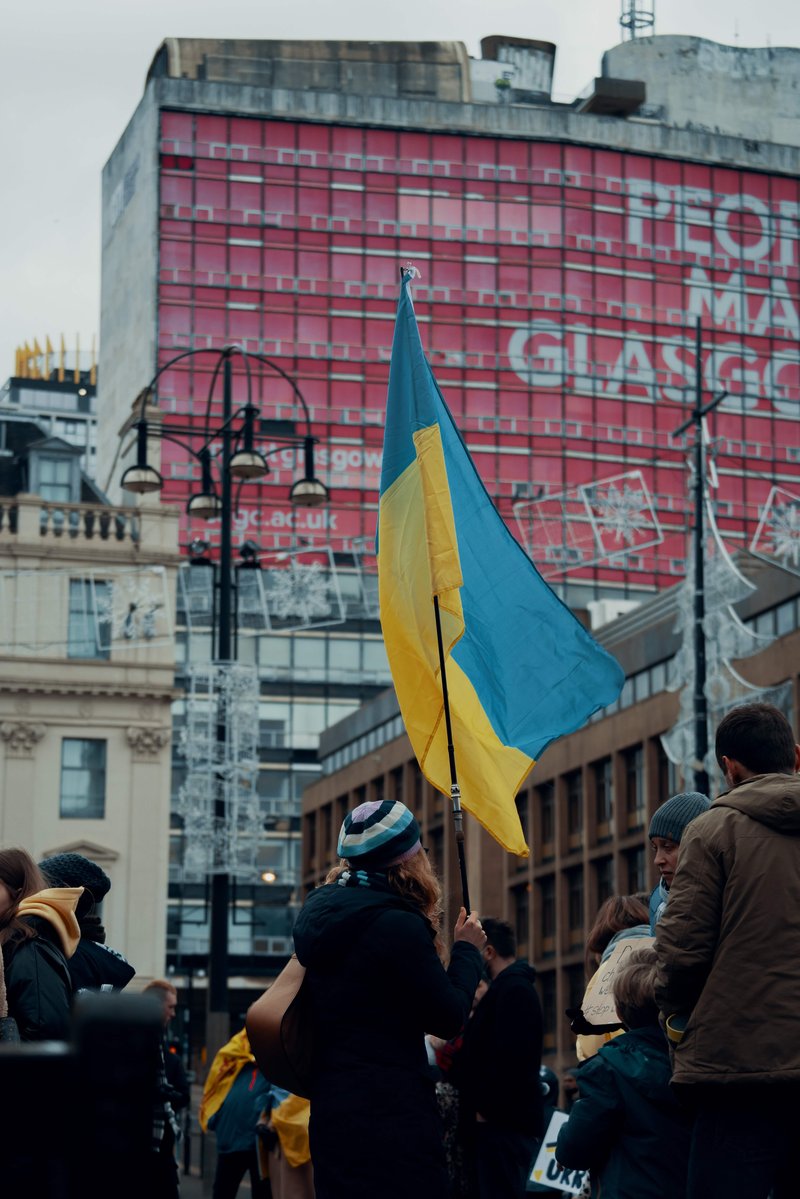
Given its size and central location, George Square Glasgow is an ideal meeting place for large groups of people. As such, it has become a known gathering place for celebrating or commiserating sporting events - or getting your voice heard.
In recent years, pro-Palestinian and Solidarity with Ukraine rallies have taken place at George Square.
Discover More about Glasgow with CityDays
Ready to discover more of what Glasgow has to offer?
CityDays have a brand new treasure and scavenger hunt in Glasgow which combines the fun of an escape room with the historic facts and whimsical trivia of a walking tour!
Take the stress out of planning your visit to Glasgow and book your adventure today!
Not visiting Melbourne this time? Don’t worry, you’ll find us all over the world.
